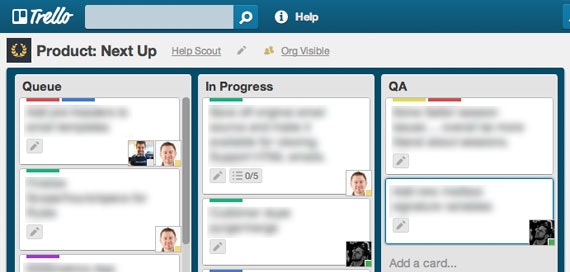Your company cannot operate successfully if the support and product teams are communicating through a string and a pair of cups.
When support is left to operate as an island, reps will only ever learn to parrot "I'm sorry." Well, “I'm sorry” to break it to you, but that’s a miserable support strategy.
Apologies are necessary when dealing with upset customers, but if there isn’t a system in place to learn from this feedback, you're just putting your support team on the receiving end of complaints with no means to fix the root of the problem.
The support team does not have the power to change the source of the complaints they receive. While user error is certainly in the mix, designers and engineers (and on occasion, marketing) are often the real source of support tickets, so they need to be kept in the loop.
How are bugs fixed, errors tackled, and products improved when nobody but support knows what customers are saying?
This is why we are so adamant about the principals and practice of Whole Company Support. If Jeff Bezos can sit down on support requests every once in a while (no joke), so can the rest of your team.
The dedicated support staff has to pick up the slack here, too. They need a system that empowers them to do more with incoming tickets than just say "I'm sorry."
What to do with customer feedback
Your support team needs a way to catalogue and submit their own feedback to the rest of your team.
A great support staff will filter customer feedback and pass along the things you need to hear about. A customer complains that your software isn't the color they like? Yeah, they can say, "Sorry orange isn't your thing, Chris!" and save your inbox.
But when they notice dozens of customers saying that they can't find very important feature? That needs to be put in a team inbox for the product and marketing teams to see.
We've described the simple system we use that is built around Trello cards. In essence, we have an inbox labeled "Ideas" that anyone can add to at their discretion. We also have cards labeled "Next Up" and "Roadmap," so people doing support know what's being worked on and what the development team has already said no to.

This can help serve as a baseline to keep everybody from multiple teams on the same page. Where is the product going? What ideas have already been suggested? Support can really compliment the "Ideas" folder here, and with time, they'll become great at recognizing true customer pain points. Remember that folders for "Bugs" and "Complaints" can also be made.
The next step isn't so easy, but it will be useful. When a problem is identified, you need to figure out how to loop in the guy/gal who owns the problem.
What does that mean? When an angry customer reaches out because your “Add to Cart” button isn't working, that isn't support's fault—your ecommerce site developer is in charge of this. How do you loop that person in?
This is mostly dependent on how your team operates. If weekly meetings are your thing, do it then. If you feel more comfortable with personal emails or live chats, so be it. You just need a way for the already busy engineering, design, and marketing departments to know what the problem is for customers, without turning them into all-access employees expected to handle burdens at a moment’s notice.
The support bulletin board
One way we like to keep the entire team up-to-date on the nitty-gritty of what's going down in support is through a system we call our "Team Huddle," which is built on the simple P2 Theme.
It serves as a virtual bulletin board where important feedback can be summed up in a weekly (or perhaps bi-weekly) extended status update, written by someone on the support team.
Ours generally consists of elements such as the following, though you can obviously include as many sections as your business needs:
Customer love. Important for feedback and morale, this is just a quick section listing some positive feedback from customers. What are they really loving about the product?
Customer success. How did onboarding of new customers go? This reveals a lot of potential problems customers may have with the product. It's regularly getting a newbie's look at your product.
What's new? Were there any new articles added to the knowledge base? Why were they added? What problems did they help customers solve?
Bugs and fixes. What did customers bring up over and over again in terms of bugs and elements they had trouble with? Ask the person writing to weigh in here—the product team will make the final call, but it's good to hear support’s thoughts, too.
Remember that this can be for the whole team to read or for certain departments, so the depth is dependent on your priorities. We keep ours modest in length and elaborate on any major concerns coming from support one-on-one. Here's the beginning of our most recent update, as an example of how it looks:

You can set this up with P2 so that all users of the "Team Huddle" get an email whenever a new update goes live. I actively look forward to our weekly update from Justin to see what people are saying about our product, content, and ways we can improve.
The necessity of empowered employees
One final important element of a support team who can do more than apologize is the freedom they are given to "give customers the pickle," or handle small problems and requests, without supervision.
Without any sort of authority, a support team just becomes a lifeless punching bag. It's bad for customers because it's like talking to a brick wall, but it's bad for your team as well.
Imagine working in a job where your boss has decided that you can't do anything that matters:
Imagine having to field calls from customers every day who you want to help, knowing that the only thing you’re allowed to do is feign that “we apologize for any inconvenience you may have experienced."
What’s so sad too is how little it would often take to resolve the situations. You bend a policy here, you expedite an order there, you bubble an issue up to a manager. A natural, caring organization designed to create passionate customers stretches and bends.
That is sad. I'd argue that the support team needs the authority to make certain judgment calls—if you don't trust them, why did you hire them in the first place?
Guidelines and coaching are better than monitoring and lifeless scripts. The trick is empowering employees with a system so that they know what they have the ability to do and don't just have an unlimited number of refunds to give away.
According to Bain consultant Rob Markey, unexpected issues can arise when companies only give employees one way to respond:
We know of one retail bank that gave their call center representatives the edict to delight customers and permission to waive up to $150 in fees for any customer without seeking any additional authorization.
The result? Customer satisfaction rose a little, but fee revenue declined.
A lot.
Instead, make sure it's known that you encourage out-of-the-box thinking and are accepting of whatever creative frugal wow an employee can deliver—but if they ever have any doubts or questions, that is when they should contact you or a support manager.
Give guidelines on what's appropriate so support knows you have their back. Create a simple document outlining instances like "If a billing mistake was made, we are more lenient with refunds and compensation," or "When customers are complaining about getting set up, offer to assist them with a 10-15 minute guided tour."
Consider it a playbook rather than a list of commandments. Trust me when I say your team will feel a lot more comfortable knowing a few fundamental moves that they are encouraged to make.



